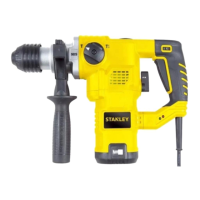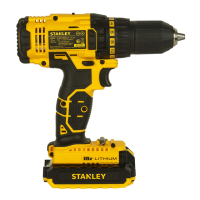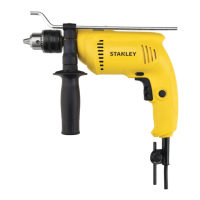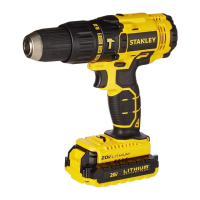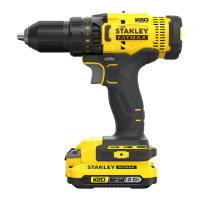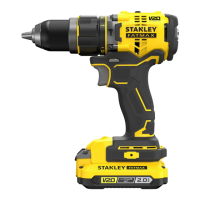8
ENGLISH
(Original instructions)
• Wear ear protectors with impact drills.Exposure to noise
can cause hearing loss.
• Use auxiliary handles supplied with the tool. Loss of
control can cause personal injury.
• Hold power tool by insulated gripping surfaces, when
performing an operation where the cutting accessory
may contact hidden wiring or its own cord. Cutting
accessory contacting a "live" wire may make exposed
metal parts of the power tool "live" and shock the
operator.
• If operating a power tool in a damp location is
unavoidable, use a residual current device (RCD)
protected supply. Use of an RCD reduces the risk of
electric shock.
Prior to operation
• Insert the appropriate bit.
• Mark the spot where the hole is to be drilled.
Proper Hand Position (fig. A, E)
Warning: To reduce the risk of serious personal
injury, ALWAYS use proper hand position as
shown.
Warning: To reduce the risk of serious personal
injury, ALWAYS hold securely in anticipation of a
sudden reaction.
Proper hand position requires one hand on the side handle
(6), with the other hand on the main handle.
Switching on and off
• To switch the tool on, press the variable speed switch
(1). The tool speed depends on how far you press the
switch.
• For continuous operation, press the lock-on button (2)
and release the variable speed switch. This option is
available only at full speed.
• To switch the tool off, release the variable speed switch.
To switch the tool off when in continuous operation,
press the variable speed switch once more and release
it.
• Based on the different applications, turn around the
speed dial (11) to control the maximum speed.
Drilling in metal
Start drilling with slow speed and increase to full power while
applying firm pressure on the tool. A smooth even flow of
metal chips indicates the proper drilling rate. Use a cutting
lubricant when drilling metals. The exceptions are cast iron
and brass which should be drilled dry.
Note: Large [5/16" (8 mm) to 1/2" (13 mm)] holes in steel
can be made easier if a pilot hole [5/32" (4 mm) to 3/16" (5
mm)] is drilled first.
Drilling in wood
Start drilling with slow speed and increase to full power while
applying firm pressure on the tool. Holes in wood can be
made with the same twist drills used for metal. These bits
may overheat unless pulled out frequently to clear chips
from the flutes. Work that is apt to splinter should be backed
up with a block of wood.
Drilling in masonry
When drilling in masonry, use carbide-tipped bits rated for
Impact drilling and be certain that the bits are sharp. Use a
constant and firm force on the tool to drill most effectively. A
smooth, even flow of dust indicates the proper drilling rate.
Screwdriving
• Select forward or reverse rotation.
Impact drilling (fig. A)
• Select the Impact mode.
• Press the switch (1).
Rotary drilling (fig. A)
• Select the rotary drilling mode.
• Proceed as described for Impact drilling.
Consult your dealer for further information on the
appropriate accessories.
Accessories
The performance of an electric tool depends on its
accessories. STANLEYaccessories are designed according
to high quality standards, to enhance the performance of
electric tool. The use of these accessories can help you
conveniently operate the tool.
Maintenance
The STANLEYcord / cordless appliance / tools are of
sophisticated design, can be used for a long time, and only
little maintenance is needed. To obtain consistent
satisfactory use, proper maintenance and regular cleaning of
the tools are necessary.
Warning! Before performing any maintenance work on the
cord / cordless electric tools, the following points must be
implemented:
• Switch off the power of the equipment / tools and pull off
the plug;
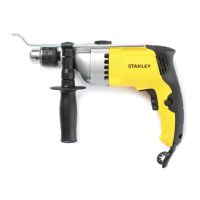
